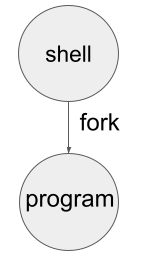opsys-sp25
CSE 30341 Spring 2025 at Notre Dame
Homework B - Processes
The following answers should be handwritten, either on paper or tablet. Submit by uploading photos/images to Canvas.
Q1 - State precisely in one sentence the effect and return value of the fork() system call in Unix.
Q2 - State precisely in one sentence the effect and return value of the execl() system call in Unix.
Now, the most common and expected way of using fork and execl is this:
pid = fork();
if(pid==0) {
execl("program",...);
_exit(1);
} else if(pid>0) {
wait(&status);
}
Which results in a single child process running “program”. And, the parent process waits for the completion of the child. This can be sketched as a process tree, like this:

But there are many other ways to put the pieces together,
some of them useful, and some of them just plain wrong.
as shown below. Suppose that a program named “shell”
executes the following code snippets. (You may assume
that fork and execl always succeed in these examples.)
Q3 - Sketch a diagram showing the outcome of this program:
fork();
execl("program",...);
Q4 - Sketch a diagram showing the outcome of this program:
execl("program",...);
fork();
Q5 - Sketch the outcome of this program:
fork();
fork();
execl("program",...");
Q6 - Sketch the outcome of this program:
for(i=0;i<8;i++) {
pid = fork();
if(pid==0) {
execl("program",...):
}
}
Q7 - Sketch the outcome of this program: (notice the !=)
for(i=0;i<8;i++) {
pid = fork();
if(pid!=0) {
execl("program",...):
}
}
Q8 - Sketch the outcome of this program:
for(i=0;i<3;i++) {
fork();
}
execl("program",...):
Q9 - Sketch the outcome of this program:
for(i=0;i<8;i++) {
execl("program",...):
}
fork();
Q10 - Sketch the outcome of this programm, and suggest why this might be a useful technique:
pid = fork();
if(pid==0) {
execl("program",...);
} else {
_exit(0);
}